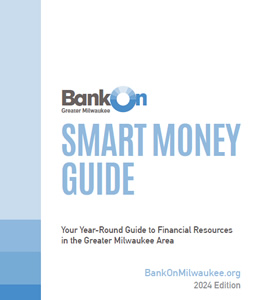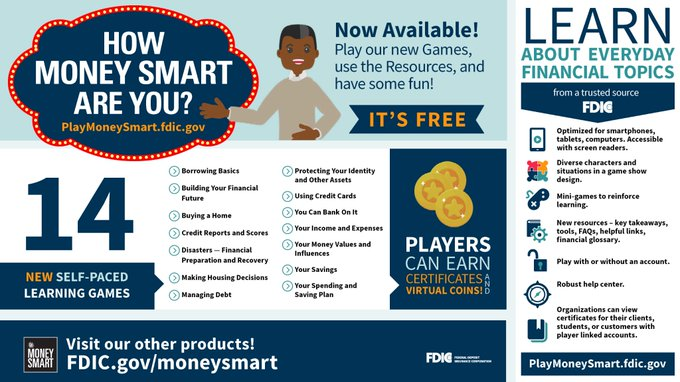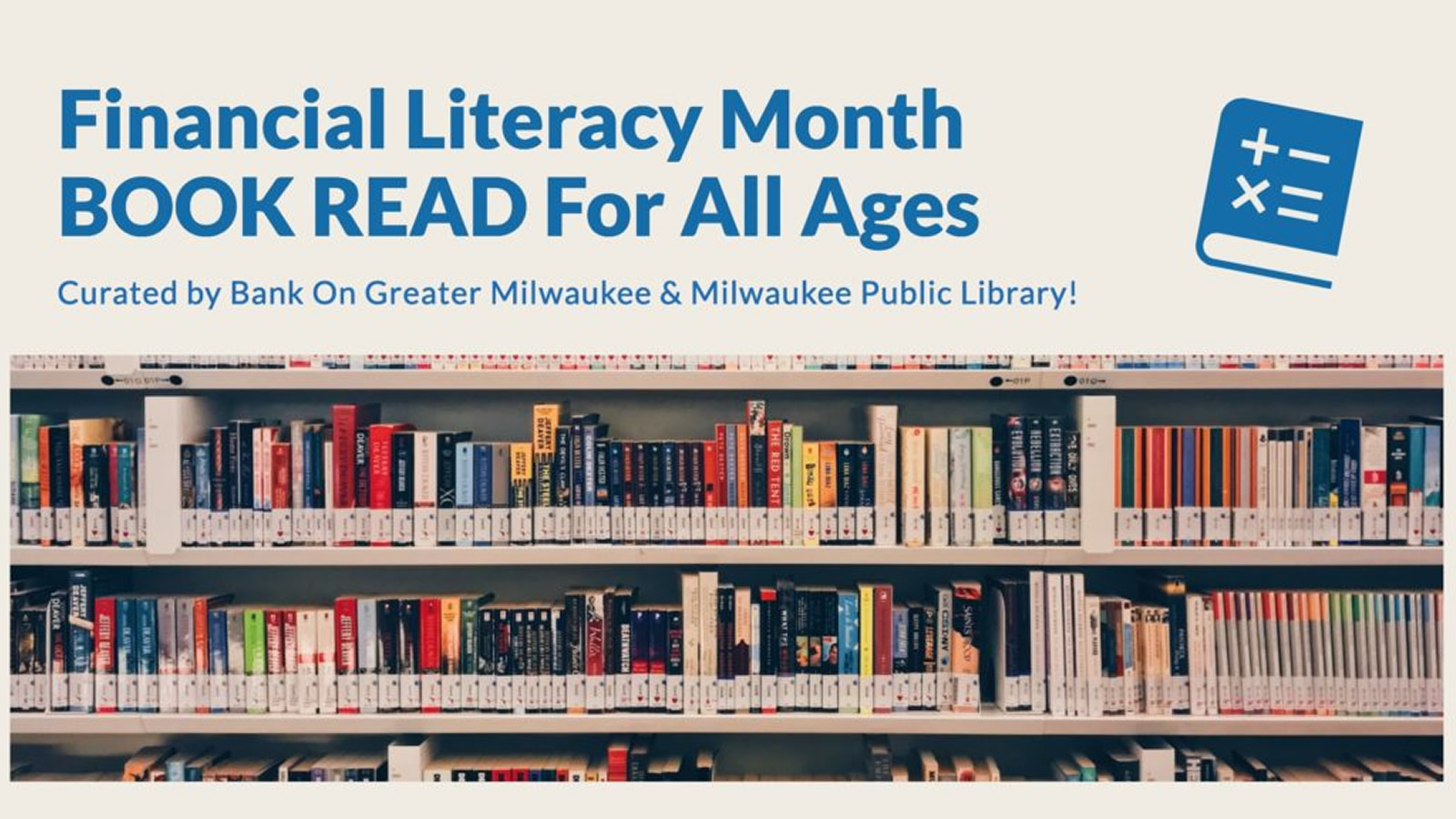Every April organizations across the county celebrate National Financial Literacy Month by hosting events and offering opportunities that help individuals and families establish and maintain healthy financial habits. Bank On Greater Milwaukee is excited to be partnering with Milwaukee Public Library to celebrate Financial Literacy Month with our Financial Literacy Month Book Read For All Ages!
Together, we have curated a list of books related to money and finances that are suitable for kids, teens, and adults. Topics addressed in each book will help you and your family grow your foundational understanding of money, explore our relationship finances, and establish and strengthen healthy financial habits.
All books are available at Milwaukee Public Library branches.
We encourage you to use the CountyCat portal to find the books you are looking through the public library system. Library branches are open but operating with limited services and hours. View the most current branch hours here.
Share your reading journey with us on social media!
We invite you to snap photos of the books you read and share them with us and the community on social media. Use the hashtag #BOGMBookRead and tag @BankOnMKE and @Milwaukee.Public.Library.
BOOKS FOR KIDS
Earn It! (Cinders McLeod)
In this introduction to the concept of earning money, an exuberant bunny learns that fame and
fortune must be earned.
Bunny Money (Rosemary Wells)
When Max and Ruby head into town to get presents for Grandma’s birthday, they run into nothing
but trouble! Ruby has a beautiful present all picked out, but of course Max has his own ideas.
Spend It! (Cinders McLeod)
A bunny learns he can’t buy everything he wants with his allowance! Sonny gets three whole carrots
a week for his allowance and wants to buy everything with it!
Barbie: Learning to Save (Mary Man-Kong)
Barbie and her sisters help Chelsea learn about saving money.
Money, Money, Honey Bunny (Marilyn Sadler)
Honey Bunny Funny bunny has lots and lots and lots of money. Some she saves, some she spends
on herself, and some she spends on her friends.
Start Saving, Henry! (Nancy L. Carlson)
Henry’s finally old enough to get an allowance, and he can’t wait to spend it every week on giant
jawbreakers, a huge pencil, and other silly things. But when Henry finds something he really wants,
he discovers that saving money can be more difficult? and more rewarding’ than he ever imagined.
Charlie Joe Jackson’s Guide to Making Money (Tom Greenwald)
Charlie Joe’s weekly allowance just isn’t cutting it and he desperately needs money to buy a Botman, the
latest gadget to sweep his middle school. Only catch is, he wants to earn the money by doing the least
amount of work possible.
Everything Money (Kathy Furgang)
Kids will also learn about money around the world from a National Geographic expert.
Money Madness (David A. Adler)
The purpose, and not just the value, of money. From bartering, early forms of currency, credit cards, and digital payment, here is a clear and thorough introduction to money.
Escape the Rat Race: Learn How Money Works and Become a Rich Kid (Robert T. Kiyosaki)
This full-color graphic novel poses the question: “Go to school, get good grades, get a good job and invest in a 401(k)?” Not today! That’s an outdated formula for success that hasn’t adapted to the Information Age. Escape the Rat Race is the story of Tim, Tina, and Red and their entrepreneurial pursuits as they learn about money. Key messages include: How to create assets and how to make your money work for you—so you won’t need to work hard for money all your life.
BOOKS FOR YOUTH & TEENS
Understanding Credit (Carla Mooney)
These texts break down the most essential components of financial literacy for young readers, illustrating how to handle money carefully and make smart choices. ‘Decision Time’ charts put children in the driver’s seat and ask them to make decisions, such as whether to pay with cash or credit. The visual graphics break down these complex ideas clearly and comprehensibly.
The History of Money: From Bartering to Banking (Martin Jenkins)
What can take the form of a stone with a hole in the middle, a string of shells, a piece of paper, or a plastic card? The answer is money, of course. But when did we start using it? And why?
Rich Dad Poor Dad for Teens (Robert T. Kiyosaki)
The secrets about money that you don’t learn in school. An age-appropriate guide encourages the development of confident and responsible money skills, providing case examples, sidebars, and attitude recommendations that demonstrate how to achieve security in today’s challenging job market.
Clever Girl Finance (Bola Sokunbi)
Written in an accessible and entertaining tone, Clever Girl Finance teaches women how to budget, save, invest, and pay off loans. Bola tells her own story, as a self-taught investor who managed to save $100,000 in 3 years on a modest salary, and tells the stories of a few women from the Clever Girl Finance community who have also achieved financial independence.
I Will Teach You to Be Rich (Ramit Sethi)
A a great book for older teenagers who want to begin adulthood on the right financial foot. Sethi’s writing style and straight-talking stance on financial responsibility will resonate with young readers. Additionally, Sethi’s advice on navigating student loans, using credit responsibly, and building a life free of both excess debt and a constant desire for more, are highly applicable for teens on the precipice of independence.
The Early Investor (Michael Zisa)
For any motivated young person who has an interest in investing and wealth building. Zisa offers comprehensive answers to questions like “What is investing?” and “Why should I invest in stocks?” as well as guidance on frugal investing, alternative investments, mutual funds, ETFs, and the basic concepts of investing and financial planning.
BOOKS FOR ADULTS
Beyond Piggy Banks and Lemonade Stands: How to Teach Young Kids About Finance (Liz Frazier)
You are never too young to learn the fundamentals of how money works. Elementary children should understand so they can make smart decisions as they grow.
The Infographic Guide to Personal Finance (Michele Cagan, CPA & Elisabeth Lariviere)
Want to better manage your money? This book will show you how by delivering information on a tough topic in graphically appealing, digestible bites.
Debt 101: A Crash Course in Debt Management (Michele Cagan)
The key to borrowing, managing, and paying off debt is understanding what it is, how it works and how it can affect your finances and your life. Debt 101 is the easy-to-follow guide to discovering how to pay off the debt you have plus learning how to use debt to your advantage. Debt 101 allows you to take control of your money with strategies best suited for your personal financial situation-whether you are buying a home or paying off student loans.
Financial Freedom (Grant Sabatier)
Money is unlimited. Time is not. Financial Freedom is a step-by-step path to make more money in less time, so you have more time for the things you love. It challenges the accepted narrative of spending decades working a traditional 9 to 5 job, pinching pennies, and finally earning the right to retirement at age 65, and instead offers readers an alternative: forget everything you’ve ever learned about money so that you can actually live the life you want. About a lot more than money, it’s about living a richer life.
The 30-Day Money Cleanse: Take Control of Your Finances (Ashley Gerstley)
Create lasting happiness with your financial situation — not by building a blistering budget but by living the life you love! In 20 days you will create a healthier, happier relationship with your money by eliminating money stressors, finally knowing where your money is going, breaking those panic-inducing bad money habits, learning the basics of how and where to invest, and making a plan that you can not only live with but enjoy.
Personal Finance for Dummies (Eric Tyson)
The bestselling Personal Finance For Dummies has helped countless readers budget their funds successfully, rein in debt, and build a strong foundation for the future. Inside, you’ll find techniques for tracking expenditures, reducing spending, and getting out from under the burden of high-interest debt.
The Total Money Makeover (Dave Ramsey)
The Total Money Makeover teaches individuals how to get out of debt as well as how to budget. The book teaches the seven baby steps to follow in order to achieve financial stability, planning ahead for upcoming financial events, like retirement, and shares stories of individuals and couples that have done so successfully.
Credit Repair Kit for Dummies (Steve Bucci)
Don’t let your credit suffer needlessly from errors or outdated information With tools and tips for fixing a bad credit report A bad credit report can hurt your chances at qualifying for loans and credit cards, and it can even get in the way when you want to rent an apartment or land a job.
The Ultimate Retirement Guide for 50+ (Suze Orman)
Suze Orman, America’s most recognized expert on personal finance, answers all the questions that keep you up at night-starting with the biggest one: it is never too late to start planning for a next act that’s fulfilling and secure. With her signature blend of compassion, insight, and expertise, Suze guides you toward a plan that will put you in control of your financial future and help you to create the retirement you deserve.
 A comprehensive resource for anyone looking for help with their personal finances. In this guide you’ll find information on a wide range of topics, plus trusted resources that can help. And be sure to scroll down to access specific topic pages.
A comprehensive resource for anyone looking for help with their personal finances. In this guide you’ll find information on a wide range of topics, plus trusted resources that can help. And be sure to scroll down to access specific topic pages.








 (414) 562-9904
(414) 562-9904
 1915 N Dr. Martin Luther King Drive, Suite 260
1915 N Dr. Martin Luther King Drive, Suite 260